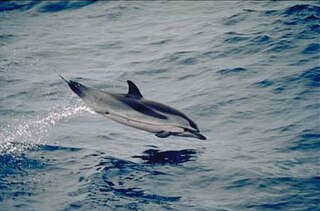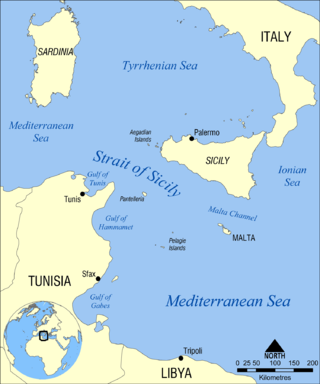
The Atlantic Ocean is the second-largest of the world's five oceanic divisions, with an area of about 85,133,000 km2 (32,870,000 sq mi). It covers approximately 17% of Earth's surface and about 24% of its water surface area. During the Age of Discovery, it was known for separating the New World of the Americas from the Old World of Afro-Eurasia.

The Mediterranean Sea is a sea connected to the Atlantic Ocean, surrounded by the Mediterranean Basin and almost completely enclosed by land: on the north by Southern Europe and Anatolia, on the south by North Africa, on the east by the Levant in West Asia, and on the west almost by the Morocco–Spain border. The Mediterranean has played a central role in the history of Western civilization. Geological evidence indicates that around 5.9 million years ago the Mediterranean was cut off from the Atlantic and was partly or completely desiccated over a period of some 600,000 years during the Messinian salinity crisis before being refilled by the Zanclean flood about 5.3 million years ago.

The striped dolphin is a dolphin found in temperate and tropical waters of all the world's oceans. It is a member of the oceanic dolphin family, Delphinidae.

The Strait of Sicily is the strait between Sicily and Tunisia. The strait is about 145 kilometres (90 mi) wide and divides the Tyrrhenian Sea and the western Mediterranean Sea, from the eastern Mediterranean Sea. The maximum depth is 316 meters (1,037 ft). The island of Pantelleria lies in the middle of the strait.

The Alboran Sea is the westernmost portion of the Mediterranean Sea, lying between the Iberian Peninsula and the north of Africa. The Strait of Gibraltar, which lies at the west end of the Alboran Sea, connects the Mediterranean with the Atlantic Ocean.

Members of the genus Lophius, also sometimes called monkfish, fishing-frogs, frog-fish, and sea-devils, are various species of lophiid anglerfishes found in the Atlantic and Indian Oceans. Lophius is known as the "monk" or "monkfish" to the North Sea and North Atlantic fishermen, a name which also belongs to Squatina squatina, the angelshark, a type of shark. The North European species is Lophius piscatorius, and the Mediterranean species is Lophius budegassa.

The Lessepsian migration is the migration of marine species along the Suez Canal, usually from the Red Sea to the Mediterranean Sea, and more rarely in the opposite direction. When the canal was completed in 1869, fish, crustaceans, mollusks, and other marine animals and plants were exposed to an artificial passage between the two naturally separate bodies of water, and cross-contamination was made possible between formerly isolated ecosystems. The phenomenon is still occurring today. It is named after Ferdinand de Lesseps, the French diplomat in charge of the canal's construction.

Palinurus elephas is a commonly caught species of spiny lobster from the East Atlantic Ocean and the Mediterranean Sea. Its common names include European spiny lobster, crayfish or cray, crawfish, common spiny lobster, Mediterranean lobster and red lobster.

Epinephelus marginatus, the dusky grouper, yellowbelly rock cod or yellowbelly grouper, is a species of marine ray-finned fish, a grouper from the subfamily Epinephelinae which is part of the family Serranidae, which also includes the anthias and sea basses. This species is the best known grouper species of the Mediterranean Sea and North Africa coast.

The Mediterranean rainbow wrasse is a small, colourful fish in the family Labridae. It can be found in the Mediterranean Sea and in the northeast Atlantic Ocean from Sweden to Senegal. Records of this species south from Senegal and the Cape Verde Islands are actually the closely related Coris atlantica.

Cephalopholis taeniops, the African hind, bluespotted sea bass or spotted grouper, is a species of marine ray-finned fish, a grouper from the subfamily Epinephelinae which is in the family Serranidae which also includes the anthias and sea basses. This species occasionally makes its way into the aquarium trade and is a target for local fisheries. It is found in the eastern Atlantic Ocean.

Caloria elegans is a species of colorful sea slug, an aeolid nudibranch, a marine gastropod mollusc in the family Facelinidae.
Flabellina confusa is a species of sea slug, an aeolid nudibranch, a marine gastropod mollusc in the family Flabellinidae. It is now known to be a synonym of Calmella gaditana.

Knoutsodonta is a genus of dorid nudibranchs in the family Onchidorididae. The radular teeth are an unusual shape and a molecular phylogeny study showed that they are not closely related to some other species of Onchidoris within which genus they were formerly placed.

Knoutsodonta pusilla is a species of sea slug, a dorid nudibranch, a shell-less marine gastropod mollusc in the family Onchidorididae.
Knoutsodonta neapolitana is a species of sea slug, a dorid nudibranch, a shell-less marine gastropod mollusc in the family Onchidorididae.
Knoutsodonta bouvieri is a species of sea slug, a dorid nudibranch, a shell-less marine gastropod mollusc in the family Onchidorididae.
Knoutsodonta cervinoi is a species of sea slug, a dorid nudibranch, a shell-less marine gastropod mollusc in the family Onchidorididae.
Knoutsodonta reticulata is a species of sea slug, a dorid nudibranch, a shell-less marine gastropod mollusc in the family Onchidorididae.

Nemesignis is a genus of sea slugs, aeolid nudibranchs, marine gastropod mollusks in the family Myrrhinidae with only one species, Nemesignis banyulensis.















